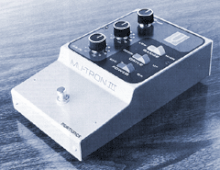Auto-wah
This articleneeds additional citations forverification.(December 2010) |

Auto-wahis a type ofwah-waheffects pedaltypically used withelectric guitar,bass guitar,clavinet,andelectric pianoetc. The distinctive choppy rhythm guitar sound on manyfunkanddiscorecordings from the 1970s popularized the effect.
Terminology
[edit]The effect is also known as a "Q-wah","T-wah","envelope following filter","envelope follower"or"envelope filter".
Operation
[edit]Instead of the effect being controlled by a foot-operated treadle pedal, as on a standardwah-wah,the effect alters in response to the volume of the input signal.[1]Like a wah, it works by adjusting the central frequency of a peaking filter, which amplifies a specific frequency and cuts off other selected frequencies.[2][3]Since the electronic circuits in the effect can respond much faster than a human musician can physically move a pedal, certain effects that a standard wah cannot achieve are only possible with auto-wah. The response of the effect is highly interactive with the dynamics of the input signal - this makes it possible to vary the response at will via slight adjustments to playing technique. Therefore, it may take some practice before the response of the auto-wah can be wilfully controlled in order to achieve a consistent sound.
A typical auto-wah circuit uses anenvelope detectorto produce a voltage representing the overall volume of the input. This signal is then used to sweep thecutoff frequencyof a filter. The filter usually has alow-passorbandpassresponse. The Boss AW-3 is an example of such a device.
There is a variant of auto-wah that utilizes a low-frequency oscillator (LFO) instead of an envelope detector to alter the effect. The filter response varies constantly with time and is not linked to playing dynamics. The Boss AW-2 is an example of such a device. The difference in sound is subtle, but careful listeners will notice the constant period of the filter sweep. The song "Falling Into Grace" by theRed Hot Chili Peppersis an example of an LFO controlled auto-wah applied to the bass guitar.
Typical controls on an auto-wah include a sensitivity control to adjust the input level to match the level expected by the envelope follower and other circuitry, a control for the initial cutoff point of the filter, and a control for the depth of the filter sweep. Some more sophisticated units offer controls for the resonance of the filter, multiple filter types, and options for sweeping the filter up or down.
Notable examples
[edit]The first envelope-controlled filter built for musical instruments was theMu-Tron III,invented by Mike Beigel.[2]Other examples include the MXR Envelope Filter and the Boss AW-2 Auto Wah (LFO controlled).
Grateful DeadguitaristJerry Garciais known for extensive use of an envelope filter (particularly the Mu-Tron III), examples being his playing on "Estimated Prophet" and "Shakedown Street".PhishguitaristTrey Anastasioalso frequently uses the effect, especially in addition to the use of distortion. The guitar solo in "What I Am"byEdie Brickell & New Bohemiansfeatures an auto-wah effect.J Mascisbecame well known for the use of the effect thanks to his role as guitarist in the groupDinosaur Jr.
References
[edit]- ^The Boss Book: The Ultimate Guide to the World's Most Popular Compact Effects for Guitar,2002, Hal Leonard Corporation
- ^abDregni, Michael (May 2014). "Get Tha Funk Out: The Mu-FX Tru-Tron 3X".Vintage Guitar.p. 146.
- ^Hunter, Dave (2004).Guitar Effects Pedals - the Practical Handbook.Hal Leonard. p. 42.ISBN9781617747021.
